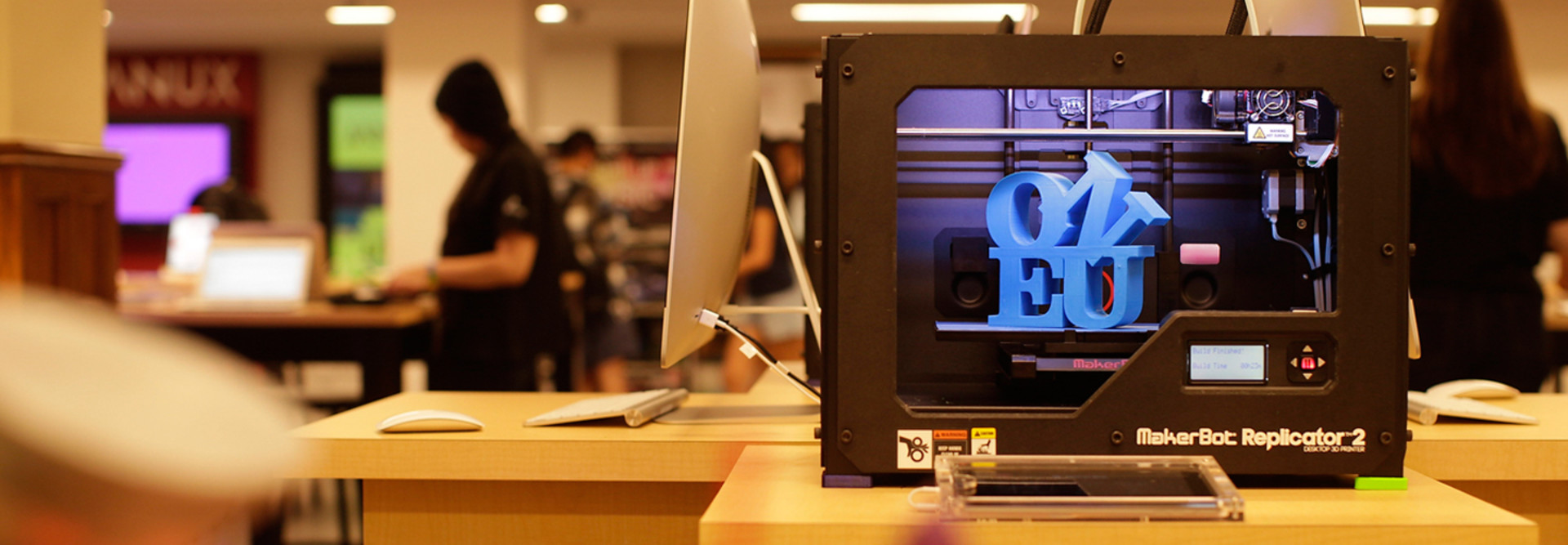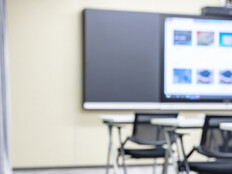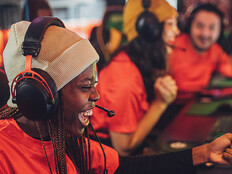Colleges Offer Hands-On Tech Engagement
The University of Oklahoma's One University Store may be a technology lover's paradise.
OU students and faculty can purchase the latest in computers, software and tech gadgets there, and try out emerging, state-of-the-art technologies such as 103-inch televisions; Google Glass, a wearable computing device that looks like eyeglasses; Oculus Rift, a virtual reality 3D gaming headset; and 3D printers.
"Students are getting a glimpse of the future," says David Goodspeed, the university's director of innovation, creativity and marketing for campus stores. "It's part retail store, part technology playground. They can try things out, they can play with them. It's a huge learning opportunity, and it can inspire them."
Similarly, when Grand Valley State University in Allendale, Mich., sought to create a space to help students and faculty engage with new technology, they launched the Technology Showcase. Housed in a new campus library, the room features cutting-edge technology such as robotics, while showing off innovative student and faculty technology projects.
The number of objects built with 3D printers in one year on the first two printers placed in service at the University of Oklahoma's One University Store
SOURCE: University of Oklahoma
Within such spaces, both universities have created immersive and engaging environments where students, faculty and staff — and even the general public — can freely explore. By providing hands-on access, officials also hope to spark ideas on how such technology might improve teaching and learning, and better engage students or inspire them to pursue their own entrepreneurial ideas.
"It's like giving students the keys to a science lab," says Kenneth C. Green, founding director of the Campus Computing Project, which studies the role of IT in higher education. "They're saying, 'Here, go explore,' and what you hope is that it's a catalyst for discovery, energy and insight."
The technology spaces, which host special events and speakers, also serve as effective marketing tools in recruitment and retention efforts.
Bridging the Digital Initiative
Two years ago, the University of Oklahoma embarked on a digital initiative, One University, to transform the student experience through technology. The effort included equipping College of Education students with tablets, transitioning from expensive print textbooks to low-cost or free digital textbooks and launching mobile apps for students. The One University Store, which opened last fall in the student union, is an important part of the initiative.
The 3,000-square-foot store, a collaboration between the IT and Web Communications departments, at any given time features eight to 12 displays showing off emerging technology. The store provides a welcoming environment that encourages students and faculty to stay as long as they want, Goodspeed says. Many K–12 classes also regularly tour the store.
"We don't want it to be like a big museum where you can't touch anything. We want people to roam around and play with things and use the technology any way they want," he says.
Since its opening, students have used the store as a meeting place, or to try out technology for classes or personal projects. After several students played with Google Glass there, they started writing apps for it, Goodspeed says. As they write software code, they come back to the store to upload their apps and test them. Other students who spent two weeks studying gaming in a computer science class visited the store to test out new offerings, including hand gesture technology that allows users to interact with computers using hand and finger movements.
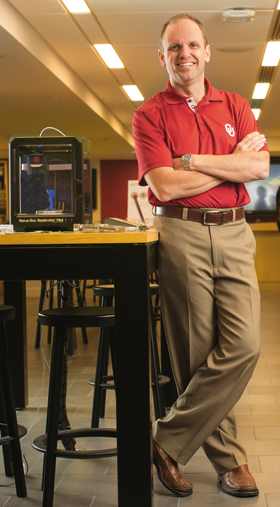
Photo by Shane Bevel
David Goodspeed says the technology featured in OU's One University Store is driven by student demand.
"Our store inspires students to create inside and outside of the classroom, and that's what it's about," Goodspeed says.
Some faculty members also are incorporating the technology in their classes. One professor brought geography students to the store to take advantage of Google Liquid Galaxy, a technology that allows users to virtually travel anywhere in the world using Google Earth. Liquid Galaxy, which uses five 60-inch TVs flipped vertically and arranged in a semicircle, provides users with a panoramic view as they virtually fly anywhere in the world, from the downtowns of cities to the ocean floor.
Overall, students report that they love the space, and constant traffic in and out of the store bears that out, Goodspeed says. He and his team of mostly student workers are always looking for exciting, cutting-edge technology to purchase and bring into the store to keep students coming back.
"My student employees are always coming up to me with ideas, and as long as it's not preposterous, we go with it," he says. "They talk with our students and tell me what they want. I can truly say the store is driven by student ideas, and that's why it's so successful."
Technology on Display
The $65 million Mary Idema Pew Library opened last year at Grand Valley State University. Designed to serve as the campus's new intellectual hub, the library is filled with flexible indoor and outdoor spaces, including quiet study areas, collaborative workspaces, a tutoring center and an IT help desk.
The Technology Showcase, a 14-by-25-foot room dedicated to emerging and innovative technology, opened in January inside the library's atrium.
The number of visitors passing by Grand Valley State University's Technology Showcase during one week this spring
SOURCE: Grand Valley State University
"We want to make it an interesting place for students to try new things and for faculty to think differently about how they teach," says Eric Kunnen, associate director of e-learning and emerging technologies for the university's IT department.
The Technology Showcase displays a dozen technologies at a time, including Google Glass, hand gesture technology, 3D printers and scanners, and several robotics technologies. One robotic lecture capture device allows a professor to place a tablet or smartphone on top of it, then record lectures. The device moves from side to side, following lecturers as they roam around their classrooms.
Offering the ability to touch and use new technology allows the campus community to better envision how they might help to solve instructional problems, Kunnen says.
"Students, faculty and staff can come together and discuss how they can improve student learning with emerging technologies," he says. "It helps to accelerate the topic of educational technology at the university."
Students are using the technology for class work as well as their own personal interests. One student used a 3D printer to restore a vintage stereo amp.
Kunnen regularly adds new technology to the room and previously had a giant touch-screen smartphone and a Bitcoin display created by a professor. This fall, the campus will deploy a new 3D projector, technology that can improve classroom learning by allowing students to better visualize objects. "If you listen to your chemistry professor lecture and the screen shows a 3D representation of a molecule, it makes learning come alive because you can better see the depth and complexity of that molecule," he says.
Overall, the showcase is doing the job its planners intended, engaging students while showing faculty all of the possibilities of next-generation educational technology tools.
"It's very valuable for them to envision what it would be like for everyone to have them, and how they could change learning," Kunnen says.
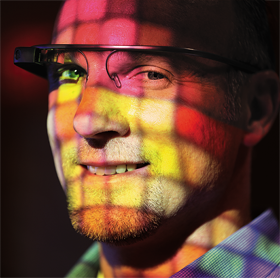
Photo: J. Kyle Keener
Grand Valley State University's Eric Kunnen
What Students Really Need
While some universities are creating spaces where students can play with emerging technologies, campuses must continue to provide the essentials.
At the University of Pittsburgh, students are demanding a mix of the experimental with tried-and-true technology. As the use of tablets and smartphones exploded on campus, Pitt's IT department installed more than 30 mobile device charging stations. Placed throughout academic buildings, computer labs and the student union, the stations look like music stands and allow up to eight students to plug in a variety of devices at the same time.
Despite the influx of student-owned devices, students continue to pack the university's six student computer labs. They remain popular because it's a formal space where they can work quietly and concentrate, CIO Jinx P. Walton says.
Pitt has also set up a mobile computing lab, complete with counters, where students can use their own notebooks and tablets to access the campus Wi-Fi network. Students can tap into university-provided services such as Microsoft Lync to collaborate with classmates or store files using online storage applications.
In recent years, the University of Pittsburgh also launched a printing service that allows students to print to any printer on campus. Students can send a print job from a personal device, a campus computer kiosk or a computer in the computer lab. When the student is ready to pick up the print job, they swipe their student ID card at their printer and it prints on demand.
Tech support remains important. At the university store, where the latest technologies are available for purchase, IT staffers are on hand to provide guidance on how to maximize students' devices, Walton says.
Pitt charges students a technology fee to support the many tech initiatives on campus and regularly surveys students to ensure IT is meeting their needs, Walton says.
"We support students' current needs, but we also keep tabs on the latest trends and student opinions, so that we can provide technology that meets needs that are still on the horizon."



